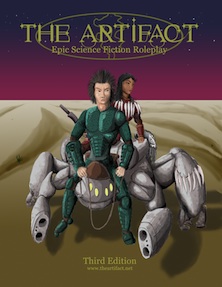Exploring in an RPG is tricky since in life and video games exploring consists mainly of moving around and looking. In life and video games people can explore by looking around and filtering their environment for themselves. This breaks down in an RPG because the GM has to filter the environment for them and if the GM includes descriptions that the players aren’t interested in they get frustrated. Long explanations of environments are about as fun for the players as the GM having their own character that gets the spotlight.
Maps
One of the ways of dealing with this is to give the players the map. Either explain that the characters spend time running around mapping or make a map part of the story. You know, the part where the old man offers to sell the PCs a map that will help them in their quest, or some variation there of. So how do you introduce exploration using a map? Maybe the map is accurate, maybe it isn’t. Things may have changed since the map was made. In essence information should be missing from the map and that fact should be obvious fairly quickly. Importantly, there should be several things for the players to discover when examining the map.
Another interesting trick I’ve had a GM use is to manufacture the equivalent of a pixel hunt. The GM drew a picture as part of the adventure to show a scene and encouraged us to look at it and ask questions about it. This is, in reality very similar to using a map, just in greater detail and was a drawing from the point of view of the character.
Combining
One of the tools that a lot of video games use in exploring is combining. While exploring the players find an item and then later they discover a situation or object that the first object can act on. This can even happen in the form of chaining objects and situations so that multiple objects are gathered and used. Players are used to this kind of “puzzle” and can get board with it quickly since they know that if they find a stone handle, there’s probably something that handle is going to fit into later but combining doesn’t have to be limited to that. Have the players find a stone mortar and pestle that don’t seem to match. The players don’t know that there’s a back story of some transient that found the handle, pulled it out and used it for a pestle to grind his food. That little extra story that the players may never really know can obscure things just enough to make it not obvious.
Layers
Layers are really the core to exploring in an RPG. The players are given what seems to be the full picture only to find a key that opens up another layer that doesn’t change what they know, but adds to it in an unexpected way.
The example of the stone handle is also an example of layers. Layers of story can be stripped away as the player’s explore. For example, that tall thin man that was following the PCs at a distance in town seems dangerous and may even fight them if cornered but he’s really there to prevent someone else from harming the players. As soon as they’ve chased their pursuer off they’re approached by a man that asks the players to go on a quest for him promising riches but is really only using them to get what he wants. One can imagine from that point a series of events that make the players think the tall man is against them, when in reality he’s trying to stop their employer.
To make the revelation of each layer the most rewarding for the players, have them show information that the players expect should be there but have it be more than they were expecting or have events move in a different direction.
Visual or Story
So when you want your players to explore, think about what type of exploration you want them to be doing. If it’s visual, maps or pictures let them filter information visually. If it’s story, combining items and places, with a bit of imagination can be useful. With any type of exploration, layers are what you’re looking for visual or story.


 The Free RPG Blog
The Free RPG Blog